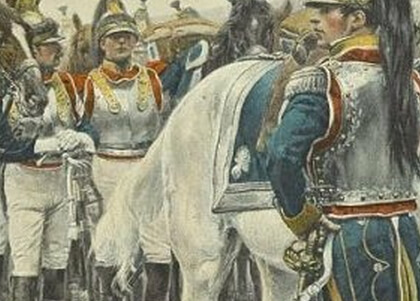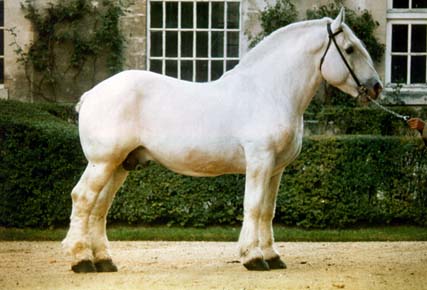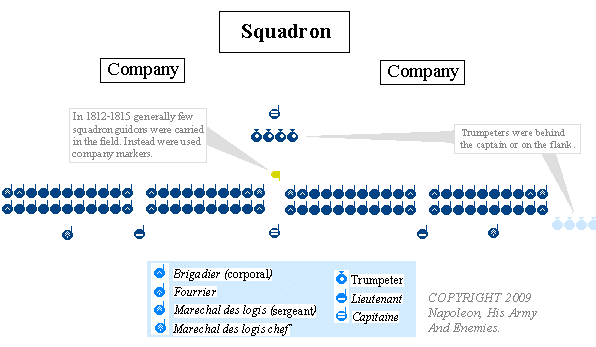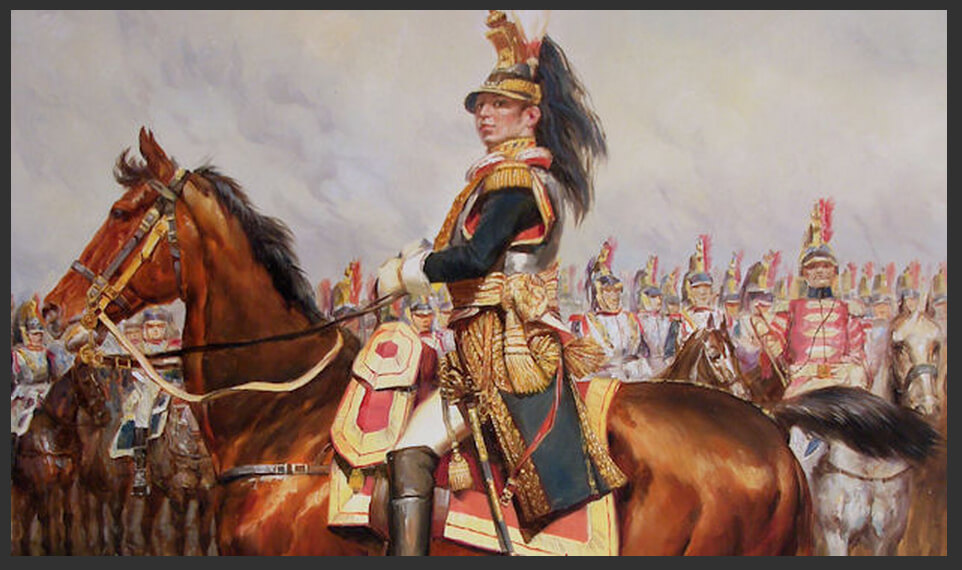“Cavalry is useful before, during and after the battle,” wrote Napoleon, and he stressed the need for audacity in its employment and careful training to achieve true discipline. He was also insistent that careful categorization according to role was of great importance.
Let us pause for a moment and look at some of the details around cavalry in the twilight days of the use of this army of an armed force.
Whilst they could prove to be an irresistible force when used correctly as Napoleon states they also fell to the advances in cannon technology, fire rates and accuracy of muskets and disciplined drilling of troops. The Frenchman was an inferior horseman and swordsman when compared to the Hessian, Baden, Polish, British, Prussian and Austrian cavalryman. Additionally the deficient maneuvering capacity of the French cavalry, compelled the French to hold it together in dense masses.
So why did the French cavalry win in so many engagements ?

One factor was certainly their superior organization, at higher levels, to most of their opponents. The French command structure and organization made it more likely that a French cavalry formation had reserves available, and the ability to direct them to exploit a break in the enemy line or plug a gap in their own, or counterattack the victorious enemy. Their discipline and tactics of using larger formations (cavalry divisions and cavalry corps) impressed even the most bitter enemies of France. Here I think the NBS system really models these command capabilities and cavalry combat effects very well.
In cavalry combat, bravery, good weapons, and fast horses alone are not enough to win.
We wont be delving into every unit and every troop type for this set of articles about Austerlitz. Just enough to obtain a flavor for the era, and understand a little bit more about what went on the battle field and some of the personalities and details about life on the field where I come across it. I have pulled this data from a wide array of sites, some Napoleonic specific, man y not. Such as horse breeding, weapons sites, wikis and the like.
The French cavalry of the Napoleonic Wars were always formed in 2 ranks. The French “Ordonnce provisoire sur l’exercise et les manoeuvres de la cavalerie” provides standard intervals and speeds for horses, and describe the tactical formations. Title III, Article VII, paragraph 404 states that two ranks of cavalry were 6 m deep. Title I, Article XII states that the ranks had an interval of 0.666 m measured from the tail of the front horse to the nose of the rear rank. I wonder if there is not a way to play at a tactical level and allow for the overall outcome of the battle thru card draws and such?
Phew sounds complicated good thing is we are playing with larger scale! Lets take a look at a typical Squadron of French Cavalry:
Source: http://napoleonia.atspace.com/FrenchCavalry.htmlorganization
Theoretical strength of French cavalry regiment was between 800 and 1,200 men. During the campaigns the numbers decreased. For example during crossing of the Rhine River (September 1805) eight cuirassier regiments had 484 men per regiment on average. In December at Austerlitz it decreased to 317 men per regiment.
Two (or three) regiments formed brigade.
Two (or three) brigades formed division.
Two or more divisions formed corps. Thus the C Corp. Which proved to be a valuable asset on the day.
Most often regiment had 3 or 4 squadrons. For example at Austerlitz 44 cavalry regiments had 153 squadrons, on average 3.5 squadron per regiment.

Leadership at Austerlitz:
Nansouty was cautious and level headed man, he commanded the superb 1st Cuirassier Division at Austerlitz (1805), Jena (1806), Eylau (1707), and Wagram (1809). In 1812 during the Invasion of Russia, he commanded the I Cavalry Corps. This cautious leader died in February 1815 in Paris and took no part in the battles of Ligny and Waterloo.comprised of 1st Brigade lead by Piston. This Brigade had the 1st, 2nd carabinier Regiments. The 2nd Brigade lead by l’Houssaye comprised the 2nd and 9th Cuirassier whilst the 3rd lead by St Germaine had the 3rd and the 12th Cuirassier.
In contrast Jean-Joseph Ange d’Hautpoul was a burly charge at any time leader who had just two brigades under command of the 2nd Division. Each had 2 regiments of Cuirassiers. At Austerlitz the 1st Brigade was lead by St Sulspice who lead the 1st and 5th regiments. It is unknown who lead the 10th and 11th regiments, who were particularly resplendent in Dark Blue coats, white breeches and pink collar and turn backs.

d’Hautpoul was born in an ancient noble family from the Languedoc he entered the French royal army as a volunteer in 1769. After having served in the Corsican legion, he transferred in 1771 to a Dragoon regiment. From 1777 on he served as an officer in the Regiment of the Languedoc and by 1792 he had become its colonel. Despite his noble birth, at the exhortations of his soldiers he was allowed to remain in the French Revolutionary Army. and he served in the 1794-1799 campaigns against the armies of the First and Second Coalitions. In August 1805 d’Hautpoul was given command of the 2nd division of cuirassiers under Joachim Murat. At Austerlitz d’Hautpoul distinguished himself by breaking the Russian center at the Pratzen heights. Called upon to charge the Russian center after the defeat of the Corps of Marshal Augereau, he was heavily wounded during his third charge. Against the advise of Larrey, he refused to have his leg amputated and he died five days after the battle.
What a proud noble looking bastard! Amazing portrait.
Napoleon formed cuirassiers in the very beginning of his reign. The first twelve régiments so-called d’Cavalerie received the strongest and tallest men and horses. They were numbered 1st, 2nd, 3rd, 4th, 5th, 6th, 7th, 8th, 9th, 10th, 11th and 12th Cuirassiers.
These men were the descendants you could say, of Medieval knights. With front and back breast plates, helmets and long straight cavalry swords. All were supposed to carry pistols. Less than 20% did. Curaissiers unlike Carabiniers used just a sword, a sign of bravery to them. Carabiniers were equipped with a long straight sword and dragoon musket. This type of heavy cavalry carried straight bladed sabre 97.5 cm long.

The straight and long saber or back sword was best when used by well aligned bodies of troops, when the opponent was to the front. This long weapon was difficult to maneuver in tight or/and chaotic settings. The saber’s heavy guard restricted the hand into the pointing position. The center of gravity of this weapon was “close to the garde” so it was easier to keep your arm outstretched to reach out toward the opponent. The narrow blade penetrated very deeply into the body. The man would lean forward with the saber extended, it made him a smaller target and in the same time gave him the greatest reach. With the center of gravity so close to the garde it was poor weapon for slashing and cuting. Its narrowness limited the blade’s penetration.
Horses were of varying breeds. But usually large 15 and 1/2 plus hands. Interesting horse color was important. The first squadron (each squadron had 2 companies) typically had black horses, the 2nd squadron had bays for the 2nd and 5th companies, the third Squadron chestnuts.
Breeds varied, Generals of course preferred the Arabian mounts which while they were not as fast as European warmbloods they were sure-footed. They were famous for elegance, toughness and almost legendary endurance. However the day to day horse of choice was one I had not heard of before.

The French horse Boulonnais of Flanders enjoyed a great popularity in every European heavy cavalry and among horse dealers. Napoleon purchased thousands of these horses for his cuirassiers. The Boulonnais is said to descend from the horses imported by Julius Caesar’s legions, which stayed along the coasts of the Pas-de-Calais before invading what is now Great Britain. Much later came the Crusades and the Spanish occupation of Flanders. These events brought a great deal of Oriental and Andalusian blood to the Boulonnais area. Additional crosses with Andalusian stock and Mecklenburg blood from Germany further shaped the breed.




5 thoughts on “French Forces at Austerlitz 1805; Cavalry”
Comments are closed.